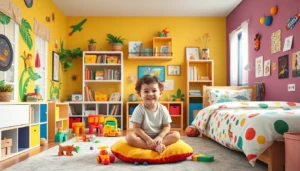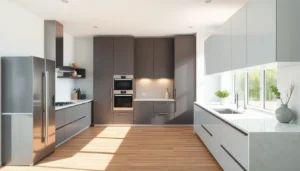Table of Contents
ToggleDesigning a kid’s room can feel like trying to assemble a puzzle with missing pieces—challenging yet rewarding. It’s not just about slapping on some paint and tossing in a bed; it’s about creating a magical space where imagination runs wild and adventures begin. After all, this is where dreams are spun and epic battles against stuffed animals take place.
From whimsical themes to practical storage solutions, the right design can transform a chaotic play zone into a serene retreat. Parents often find themselves caught between their child’s wild ideas and the need for a functional space. But fear not! With a sprinkle of creativity and a dash of humor, designing a kid’s room can be a fun journey. Let’s dive into the world of vibrant colors, playful patterns, and clever organization that’ll make any child feel like the king or queen of their castle.
Importance Of Kids Room Design
Creating a well-designed kids’ room plays a crucial role in a child’s development. A thoughtfully organized space promotes creativity and supports growth. Each element, from furniture to color schemes, influences a child’s mood and behavior.
Functional layouts make it easier for kids to engage with their environment. A designated area for play encourages exploration, while a quiet nook invites reading and relaxation. Vibrant colors and playful patterns stimulate imagination, allowing children to express their unique personalities.
Safety also remains a top priority in kids’ room design. Choosing non-toxic materials and soft furnishings protects children from potential hazards. Ergonomic furniture aligns with their physical development, ensuring comfort during activities like studying or playing.
Organization enhances efficiency, teaching children to maintain their space. Incorporating storage solutions helps manage toys, clothes and school supplies effectively. Labeling bins and shelves encourages responsibility, fostering a sense of ownership.
Personal touches contribute to a child’s sense of identity. Displaying their art or photographs creates a connection to their interests and achievements. Encouraging involvement in the design process empowers kids, allowing them to influence their surroundings.
Lastly, a well-designed room nurtures emotional well-being. A cozy, inviting atmosphere offers a retreat from daily stresses, supporting mental health. When parents prioritize thoughtful design, they create environments where kids feel secure and inspired.
Essential Elements Of Kids Room Design

Designing a kid’s room involves several essential elements that create a functional and inspiring space. Each choice influences a child’s experience, contributing to comfort and creativity.
Color Schemes
Selecting appropriate color schemes plays a vital role in a child’s room design. Bright, vibrant colors encourage playfulness, while softer hues promote relaxation. Pairing complementary colors creates visual interest, stimulating a child’s imagination. Specifically, consider a palette with calming shades like blues or greens alongside energetic tones such as yellows or reds. Incorporating wallpapers with patterns adds depth, allowing for personal expression through a playful aesthetic. Each color choice should reflect the child’s personality, making the room a delightful retreat.
Furniture Selection
Furniture selection significantly impacts both functionality and safety in a child’s room. Prioritize ergonomic pieces that support growth and development. Opt for multi-functional furniture, such as beds with storage drawers or desks that can grow with the child. Every item should withstand wear, so look for durable materials that resist damage. Consider including soft furnishings, like bean bags or cushioned chairs, that invite relaxation and play. Additionally, ensure that furniture is appropriately sized for the child to encourage independence and ease of use.
Layout Considerations
Layout considerations determine how a child interacts with their space. Arranging furniture to create distinct play and study zones promotes creativity and focus. A clear flow of movement enhances accessibility, allowing the child to navigate the room effortlessly. Place furniture away from walls to foster a sense of openness. Implementing storage solutions can keep the space organized, teaching children responsibility. Flexibility in layout supports change as the child grows, adapting the room to different needs over time.
Creative Themes For Kids Rooms
Creative themes transform kids’ rooms into unique spaces filled with imagination. These themes cater to a child’s interests and can evolve as they grow.
Popular Themes
Adventure themes resonate well with children. Jungle motifs include animal prints and tree decals. Space themes captivate with starry wallpapers and astronaut bedding. Fairy tale designs feature castles and mythical creatures, sparking a sense of wonder. Sports themes incorporate team colors and equipment, inspiring energy and activity. Each of these themes encourages children to explore their passions and imagine new adventures.
Personalization Tips
Personalization adds a special touch to kids’ rooms. Incorporating a child’s favorite colors creates a sense of ownership. Displaying their artwork on walls fosters pride and creativity. Using custom bedding tailored to interests enhances comfort and style. Organizing a bookshelf with personalized labels encourages literacy and responsibility. These small, meaningful adjustments empower children, making their space feel truly theirs.
Practical Tips For Small Spaces
Designing a kids’ room in a small space presents unique challenges but also offers opportunities for creativity and optimization.
Maximizing Storage
Utilizing vertical space becomes crucial in small rooms. Install shelves above furniture to keep items stored out of reach while remaining accessible. Bins and baskets under beds provide hidden storage, making rooms feel less cluttered. Consider utilizing multi-tiered storage units to organize toys and books effectively. Wall-mounted organizers for art supplies or craft materials keep essentials visible and tidy. Each solution should reflect a child’s habits and preferences to ensure the space remains functional.
Multi-Functional Furniture
Selecting furniture that serves multiple purposes enhances space efficiency significantly. A bed with built-in drawers offers both sleeping and storage areas for clothes or toys. Folding tables or desks allow for playtime flexibility while conserving space when not in use. Couches that convert into beds accommodate sleepovers without requiring additional space. Opt for ottomans that double as storage units to help manage clutter. Each piece of furniture must align with the overall design theme while enhancing usability.
Safety Considerations In Kids Room Design
Safety in kids’ room design is crucial for creating a secure environment. Parents should prioritize using non-toxic materials in paints, furniture, and decor to protect children’s health. Choosing furniture with rounded edges decreases the risk of injuries during playtime.
Additionally, securing heavy furniture to walls prevents tipping hazards. Consider using anchor brackets or straps for bookshelves and dressers. A safe floor surface, such as soft carpets or foam mats, cushions falls and enhances comfort.
Incorporating adequate lighting is also vital. Bright, well-lit spaces improve visibility, particularly in areas dedicated to play and study. Opting for night lights can provide reassurance during bedtime and decrease anxiety.
Rounding out safety, parents should assess the layout for potential hazards. Keep cords for blinds and electrical devices out of reach. Storing toys in designated bins prevents tripping hazards, ensuring pathways remain clear.
Maintaining accessibility enhances safety. Children should easily reach their belongings without needing to climb. Multi-functional storage solutions, like ottomans or benches with hidden compartments, offer a clutter-free environment while promoting organization.
Periodic checks of the room for loose items, small toys, or broken furniture maintain ongoing safety. Regularly replacing worn or damaged items also prevents accidents. By implementing these safety considerations, parents create a nurturing space that promotes creativity while prioritizing children’s well-being.
Designing a kid’s room is a rewarding journey that blends creativity with functionality. By embracing vibrant themes and personal touches, parents can create spaces that inspire imagination and growth. Each design choice plays a vital role in shaping a child’s environment and emotional well-being.
Safety and organization remain paramount in this process. Thoughtful layouts and multi-functional furniture not only enhance usability but also teach children responsibility. As they engage in the design process, kids develop a sense of ownership and pride in their space.
Ultimately, a well-designed kids’ room nurtures creativity and provides a cozy retreat. It’s a space where children can explore their passions and thrive, making it a crucial aspect of their development.






